BACK
TO
WEATHER-BLOG
MENU
New!
Fine
Art
Prints
&
digital
images
for
sale-
Welsh Weather
& Dyfi Valley landscapes Slide-Library - Click HERE
| It's
May
25th and the unsettled conditions continue to affect the Machynlleth
area with one low after another trundling along with their wind and
rain, including one on Monday 23rd that brought widespread severe gales
to Scotland and Northern Ireland, with attendant disruption to travel
and power infrastructure. Nothing of course in comparison to the
devastating tornado outbreaks that have being affecting parts of the
USA, with Joplin MO the latest casualty late on the 22nd, when a near
mile-wide tornado now rated at EF-5 pretty much destroyed the southern
part of the city. On the same day over here, heavy showers were forecast but
the main forcing passed though in the early morning, with thunder
waking me up just before 0600. For once, showers were not what was
wanted as I was to lead a Mid Wales Geology Club field-trip in the Coed
y Brenin forest near Dolgellau. The aim of the trip was to examine the
famous and huge, but unworked, copper-deposit and associated features.
Unfortunately, the showers continued all day with barely a break so
that it was a group of dripping geologists that left the area later
that afternoon. But I was able to get some photos, so we can have a
look at this fascinating area.
Coed y Brenin is an excellent area for geology enthusiasts with all sorts to see: in fact there is a waymarked "volcano trail" that I put together with the Forestry Commission some years ago, that features some of the locations illustrated below. Leaflets are available from the Visitor Centre on the eastern side of the A470 several miles north of Dolgellau, and a trail guide (PDF) can be downloaded from the following link: http://www.forestry.gov.uk  First stop was the famous Turf Copper mine, unique in Wales, as it worked not rock but a bed of peat impregnated with the metal. Contemporary descriptions are worth repeating. A.C. Ramsay, Geological Survey of Great Britain, 1866: "It was in a hollow in the hills formed by this talcose rock, about half a mile south and west of Moel Hafod-Owen, that the well-known Turf Copper Mine was situated. The drainage of the ground occupied by the greenstone and talcose schist runs into it, and the water percolating through the rocks and rising in springs, carried copper in solution from those specks and strings [of copper and iron sulphides] that are more or less diffused through the mass of the hill above. In this manner the peat moss appears to have been partly saturated with copper in the state of a soluble carbonate. The turf was pared from the surface and burnt in kilns, and a large residue of valuable copper was afterwards separated from the ashes. Many thousand pounds' worth were thus extracted." W.J. Henwood of Penzance, Cornwall, 1856: "Some of the lowest portions of the upper peat-bed were so rich in copper, that they were carried to the Swansea smelting works in the condition in which they were extracted; some of the leaves are said to have been covered with a thin pellicle of bright metallic copper; nuts were coated in like manner, and on being broken afforded also a kernel of the same; and I was informed that the copper was in some cases deposited between the fibres of the wood; so that on being cut it exhibited alternate layers of vegetable matter and metal." Today, the area is an expanse of heather with a few ruined buildings, including the kilns where the peat was burned. The most striking thing on first acquaintance is the unusual plantlife: 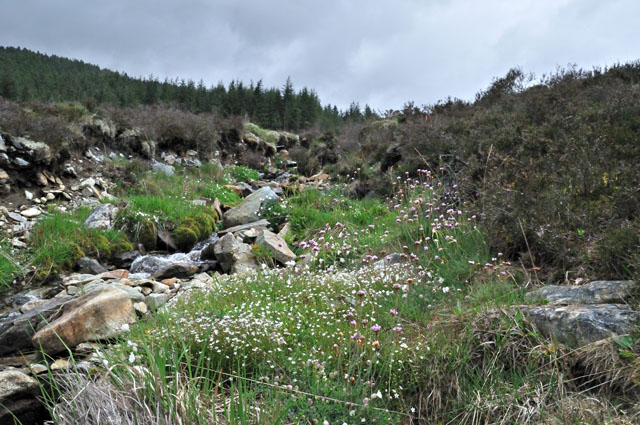 Late May is the best time to visit, when everything is in bloom. Three flowering plants stand out in particular. This is Vernal Sandwort: 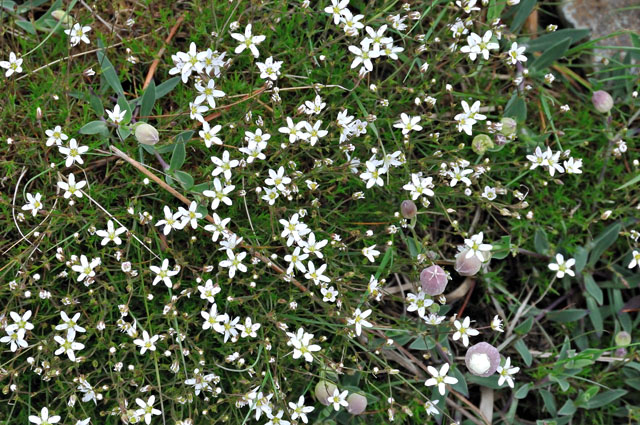 This is Sea-Campion: 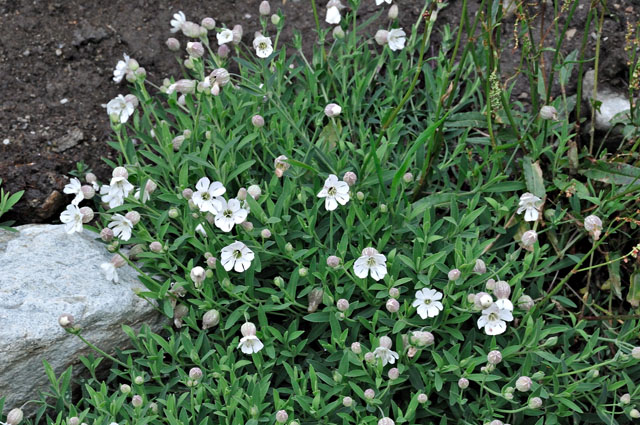 And this is Sea-Thrift:  Thrift and the white Campion are plants one would normally expect to find along our sea-cliffs, not miles inland in a peat-bog! Along with the Sandwort, the reason why they thrive here is that they are strongly metal-tolerant: they are able to grow where other plants struggle. The botany of Turf Copper is so unusual that the site is a SSSI, and has been the subject of much scientific study. From Turf Copper we walked down into the valley of the Mawddach and followed the forest-road upstream, passing a few old hard-rock mineworkings, where the presence of copper-ores was evidenced by colourful staining from copper salts: 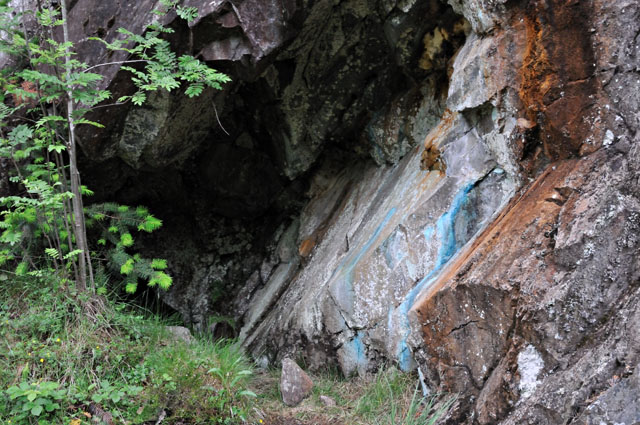
At one point, a footbridge crosses the Mawddach, up in spate after the recent prolonged rainfall....  Close-up: we have enough water again now, especially compared to southern England! 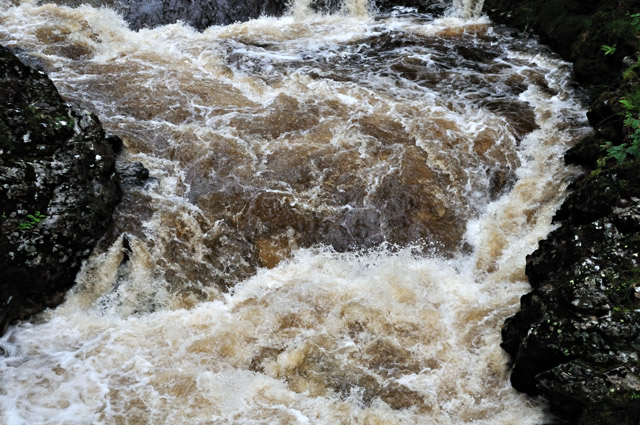 We continued to a sharp bend in the river, where after the catastrophic 2001 flash-flood the road had to be rebuilt and a new cutting made. This is an excellent rock-exposure. The lower part, greyish in the image below, is the Lower Cambrian Gamlan Formation, whilst in the upper part of the face is the Middle Cambrian Clogau Formation. Here we see a transition from pale grey mudstones and siltstones to a dark grey sulphide and organic-rich mudstone, indicating a significant environmental change... 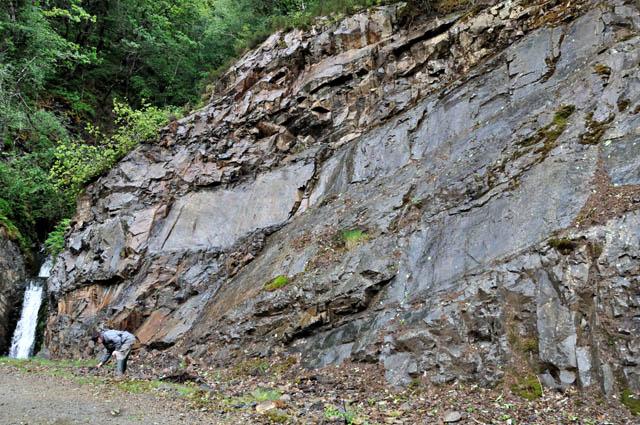 The best place to see these rocks, though, is on the coast at Friog, near Fairbourne, after winter storms have scoured the foreshore of green weed, revealing beautifully-clean exposures such as that illustrated below: 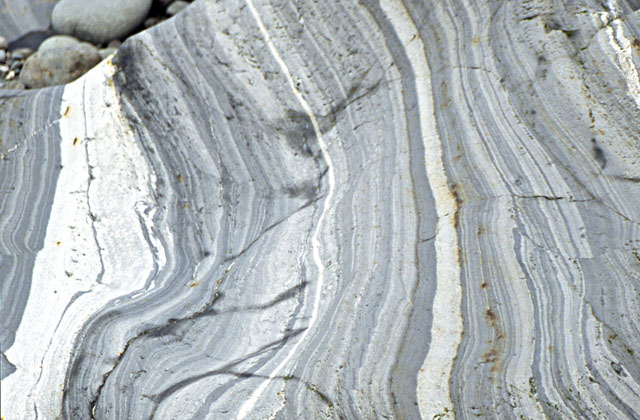 When the Clogau Formation was being deposited, Wales was situated on the margin of a small island just off the coast of the continent of Gondwana - the latter straddling the South Pole! The cutting also reveals several dykes - these are steeply-inclined sheets of crystalline igneous rock that formed when molten magma was injected up through the sediment. In the image below, we have Gamlan Formation siltstones on the left (with sedimentary layering just visible) and the dyke-rock, called tonalite, on the right 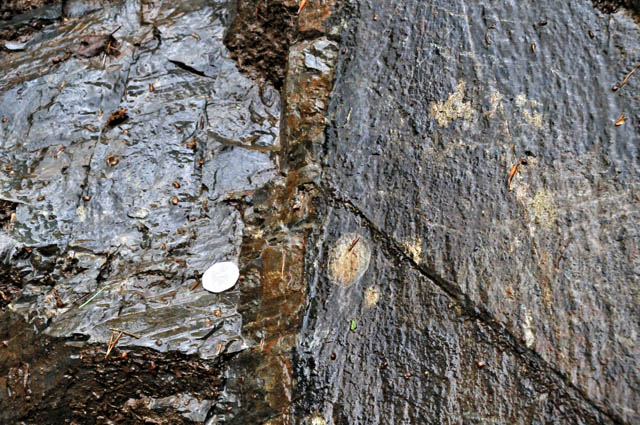 Retracing our steps we then turned SE, heading up out of the valley, passing a newly-made cutting with fresh porphyritic intrusive rock on show. A porphyritic rock is one in which one or more of the constituent minerals occurs in much larger crystals (called phenocrysts), set in a groundmass consisting of smaller crystals of all the other minerals. What happened was that the phenocrysts crystallised out first, thus having time to grow for a while, and were then transported within the magma to where that was intruded, cooled-off and the other minerals all crystallised. In this case the phenocrysts are white feldspar. 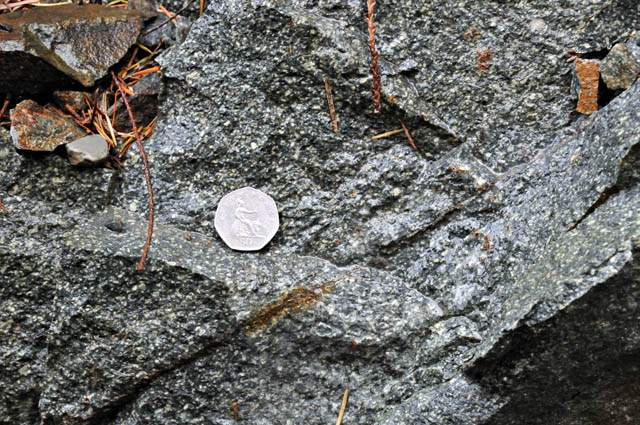 Continuing up the track, an abrupt change was apparent, seen in the image below. It was raining too heavily to take a decent image so here's one taken on a better day, last October when I was taking Cardiff University students around:  The spectacular yellow colours are iron oxides and the reason for their abundance here is that the rocks are altered, the alteration taking the form of pyritisation i.e. large amounts of iron pyrites have been added to the rock. This is the Pyrite Halo of the Coed y Brenin copper deposit, the hill in which the rocks were full of specks and strings of copper sulphides as described in 1866 by Ramsay above. Continuing southwards past the hamlet of Capel Hermon, we reached the copper deposit itself. If you imagine the pyrite-halo as a polo-mint, the orebody is the hole in the middle. There are very few good exposures of it due to overburden cover and this is the best, excavated in 1998 under my supervision and with funding from CCW. Although only 3-4 metres high, it shows a lot of interesting features: 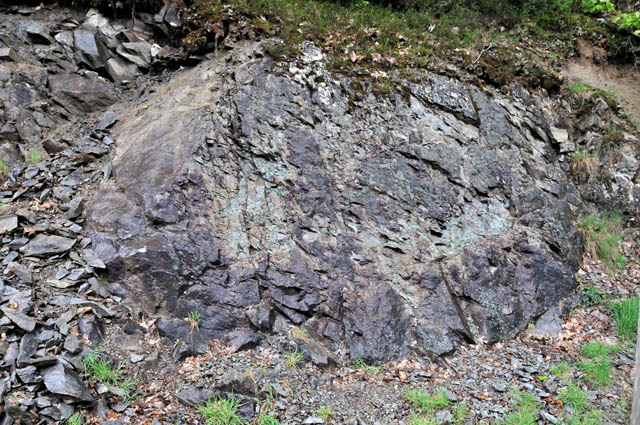 The exposure consists of another porphyritic intrusive igneous rock, but in this case it is highly mineralised with ores of copper, especially where it is rather shattered - the shattering created pathways through which the mineralising fluids carrying the copper were able to travel: 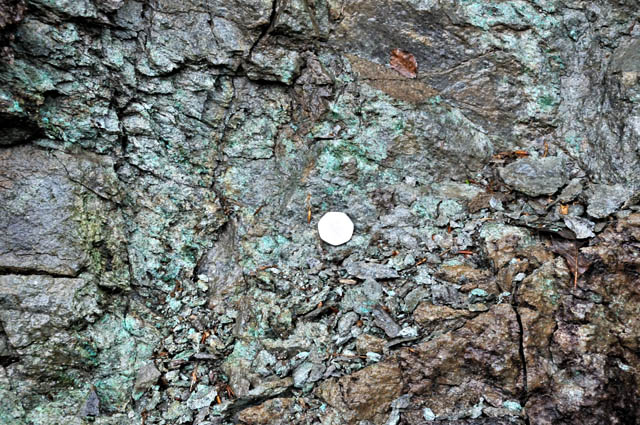 With the rain falling harder than ever, it was difficult to make out much detail, but below is one of the many samples collected when the excavation was done - most are now down at the National Museum in Cardiff. 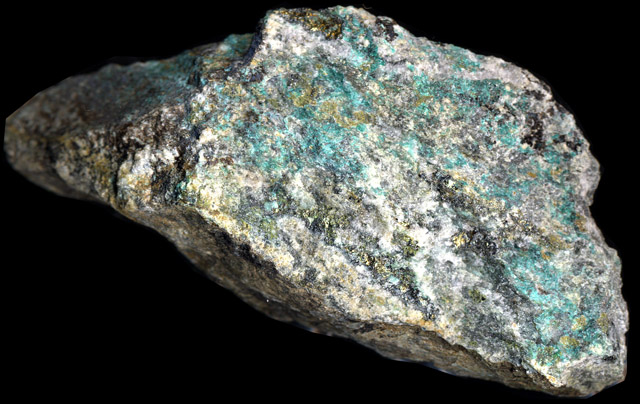 In this handsized chunk, there are specks and strings, just as Ramsay described, of copper ore. The dark grey areas are the copper-arsenic sulphide, tennantite, while the brassy-yellow areas are the copper-iron sulphide, chalcopyrite. Another copper-iron sulphide, bornite, also occurs here. The bright blue-green mineral is the copper-calcium arsenate, tyrolite. It is of relatively recent origin, formed by weathering of the sulphides by groundwaters. Following up Ramsay's comments, the mineral exploration company Riofinex did a lot of work here in the 1960s and 70s, including much core-drilling. They established that there is a body of ore some 200 million tonnes in size and carrying an average of 0.3% copper, with traces of gold and molybdenum. Plans were drawn up to work it, but mining would have required a large open-pit and with the area being in the Snowdonia National Park, and included as part of the view below, the scheme was eventually shelved. 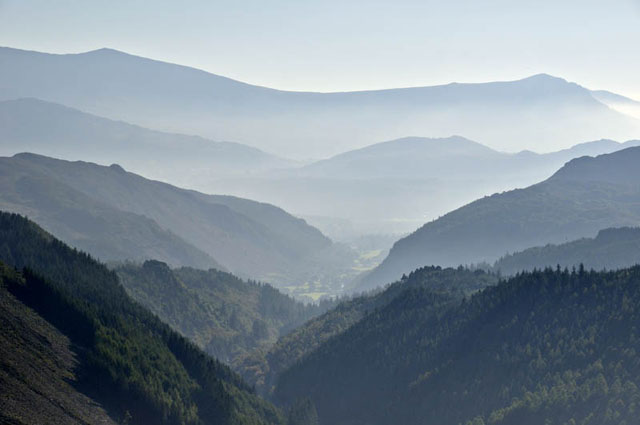 The only recent mineral working has been gold-panning, but that, too, has lately changed - the following notice appeared at several points along the forest's rivers in Summer 2010:  Personally I think this is a pity but I understand the reasons behind the ban - excessive amounts of excavation, digging into vegetated river-banks and so on. Sadly, such things have brought an end to what was a pleasurable hobby for many, myself included at one time, over many years. My own reasons for giving up were rather different - apart from getting increasingly-diverted into weather-photography, it was this find: 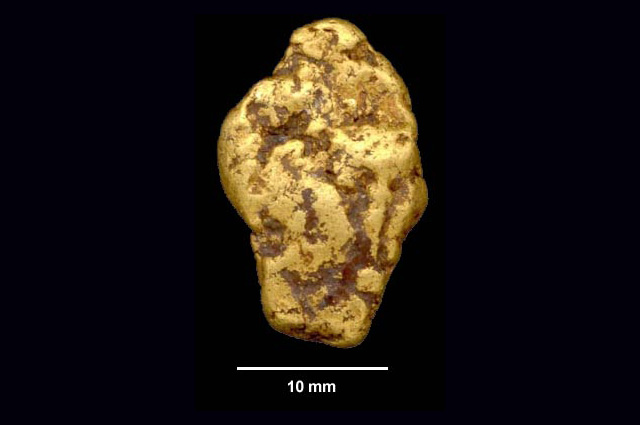 For years, I'd spent the occasional day in mid-river, up to my waist in water, working hard scraping about under boulders to find maybe half a gram of flakes and dust, getting wet, bruised, filthy, midge-bitten and tired. The nugget above, weighing a hefty 6.5 grammes, was spotted during a quick walkabout immediately after the great flash-flood in July 2001, stuck in a flood-scoured crack a foot above water-level. Many times bigger than anything else I had found there over many years' gutbusting effort, all I had to do on this occasion was bend down and gently prise it free with the ignition-key from my landrover! The irony was not lost on me... I went panning occasionally for a short time afterwards but things were never really the same again and the call of the skies and my involvement in the climate debate won in the end! On the home front, the veg-garden is in Full Steam Ahead mode. Here's the shallot-jungle, with a bank of Cranesbill covering the retaining timbers to the left: 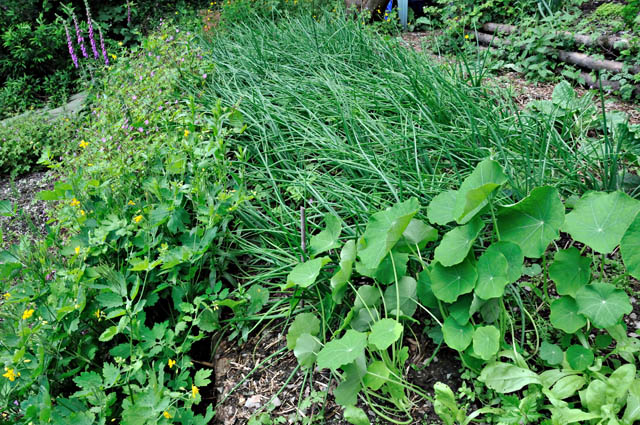 The top of the garden, which I have left to Nature, is starting to resemble a woodland clearing:  Creating and maintaining a balance between cultivated veg and wild flowers has attracted a phenomenal variety of insect life to the plot. The flowers are attracting scores of bumble-bees and the butterfly-count continues to grow with this Wall Brown:  This Red Admiral was flying around the other day but wouldn't settle in the garden itself, preferring the woodland above the top boundary: 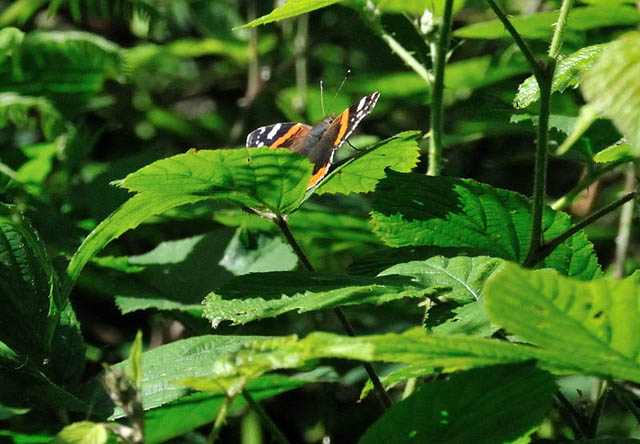 So that's nine species so far for the year - not bad! The water-storage system is now overflowing and a few dryer, warmer days would be welcome, although the charts show little in the way of a prolonged heatwave for the time being: there are hints of a warmer, dryer early June but nothing along the lines of the typically sensationalist stuff that has appeared in sections of the popular press and that I keep having to debunk in conversations with people! Why do they print rubbish like that? More soon! |
|
BACK TO WEATHER-BLOG MENU New! Fine Art Prints & digital images for sale- Welsh Weather & Dyfi Valley landscapes Slide-Library - Click HERE |